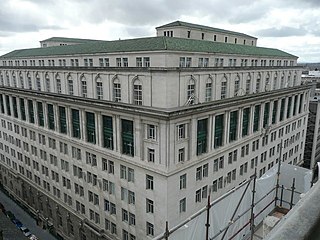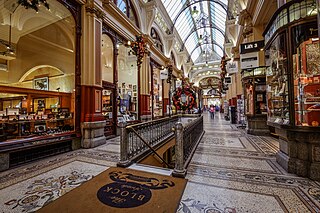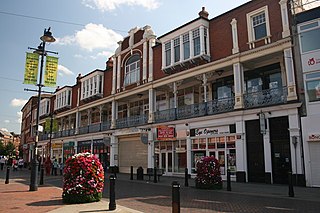
The Galleria Vittorio Emanuele II is Italy's oldest active shopping gallery and a major landmark of Milan. Housed within a four-story double arcade in the centre of town, the Galleria is named after Victor Emmanuel II, the first king of the Kingdom of Italy. It was designed in 1861 and built by architect Giuseppe Mengoni between 1865 and 1877.

India Buildings is a commercial building with its principal entrance in Water Street, Liverpool, England. Mainly an office building, it also contains an internal shopping arcade and the entrance to an underground station. It was built between 1924 and 1932, damaged by a bomb in 1941, and later restored to its original condition under the supervision of one of its original architects. The building, its design influenced by the Italian Renaissance and incorporating features of the American Beaux-Arts style, occupies an entire block in the city.

The Arcade in downtown Cleveland, Ohio, is a Victorian-era structure of two nine-story buildings, joined by a five-story arcade with a glass skylight spanning over 300 feet (91 m), along the four balconies. Erected in 1890, at a cost of $867,000, the Arcade opened on Memorial Day, and is identified as one of the earliest indoor shopping arcades in the United States. The Arcade was modified in 1939, remodeling the Euclid Avenue entrance and adding some structural support. It was designated a National Historic Landmark in 1975.

The Queen Victoria Building is a heritage-listed late-nineteenth-century building located at 429–481 George Street in the Sydney central business district, in the state of New South Wales, Australia. Designed by the architect George McRae, the Romanesque Revival building was constructed between 1893 and 1898 and is 30 metres (98 ft) wide by 190 metres (620 ft) long. The domes were built by Ritchie Brothers, a steel and metal company that also built trains, trams and farm equipment. The building fills a city block bounded by George, Market, York, and Druitt Streets. Designed as a marketplace, it was used for a variety of other purposes, underwent remodelling, and suffered decay until its restoration and return to its original use in the late twentieth century. The property is co-owned by the City of Sydney and Link REIT, and was added to the New South Wales State Heritage Register on 5 March 2010.

The Sydney Town Hall is a late 19th-century heritage-listed town hall building in the city of Sydney, the capital city of New South Wales, Australia, housing the chambers of the Lord Mayor of Sydney, council offices, and venues for meetings and functions. It is located at 483 George Street, in the Sydney central business district opposite the Queen Victoria Building and alongside St Andrew's Cathedral. Sited above the Town Hall station and between the city shopping and entertainment precincts, the steps of the Town Hall are a popular meeting place.

The Great Western Arcade is a covered Grade II listed Victorian shopping arcade lying between Colmore Row and Temple Row in Birmingham City Centre, England.

Lord Street is the main shopping street of Southport, in Merseyside. It is 1 mile (1.6 km) long, with a roundabout marking each end of the street. There are many water features, gardens and architectural buildings along the entire street, with a mix of residential, commercial and public buildings. It was laid out in the early 19th century.

The Block Arcade is a historic shopping arcade in the central business district of Melbourne, Victoria, Australia. Constructed between 1891 and 1893, it is considered one of the late Victorian era's finest shopping arcades and ranks among Melbourne's most popular tourist attractions.

The Strand Arcade is a heritage-listed Victorian-style retail arcade located at 195–197 Pitt Street in the heart of the Sydney central business district, between Pitt Street Mall and George Street in the City of Sydney local government area of New South Wales, Australia. It was designed by John B. Spencer, assisted by Charles E. Fairfax; and built from 1890 to 1892 by Bignell and Clark (1891), with renovations completed by Stephenson & Turner (1976). The only remaining arcade of its kind in Sydney, the property was added to the New South Wales State Heritage Register on 13 December 2011.

The Jāmeh Mosque of Isfahān or Jāme' Mosque of Isfahān, also known as the Atiq Mosque and the Friday Mosque of Isfahān, is a historic congregational mosque (Jāmeh) of Isfahan, Iran. The mosque is the result of continual construction, reconstruction, additions and renovations on the site from around 771 to the end of the 20th century. The Grand Bazaar of Isfahan can be found towards the southwest wing of the mosque. It has been a UNESCO World Heritage Site since 2012. It is one of the largest and most important monuments of Islamic architecture in Iran.

Barton Arcade is a Victorian shopping arcade in Manchester, England, located between Deansgate and St Ann's Square. It was constructed by Corbett, Raby, and Sawyer in 1871.

The Southport Winter Gardens was a Victorian entertainment area located within the town of Southport, Merseyside. The original winter gardens comprised a theatre, opera house, aquarium, a small zoo, conservatory, promenades and halls situated under the grand glass domes.

The Nicholas Building is a landmark historic office and retail building located at 37 Swanston St, at the intersection of Swanston Street and Flinders Lane, in the Melbourne central business district, Victoria, Australia. Designed by architect Harry Norris and completed in 1926, it is the grandest example in Melbourne of what is known as 'Commercial Palazzo' style, featuring a solid base, vertical middle floors, and a large cornice. It has housed a range of small businesses, and is now known for its creative industry tenants such as fashion designers and artists and specialist retailers. It had the longest operating manual lifts in the city, and the ground floor Cathedral Arcade is one of the most notable 1920s interiors in the city. The building is listed by the National Trust and by Heritage Victoria.

Charters Towers Stock Exchange Arcade is a heritage-listed shopping arcade at 76 Mosman Street, Charters Towers City, Charters Towers, Charters Towers Region in Queensland, Australia. It was designed by the Sydney architect Mark Cooper Day and built in 1888 by Sandbrook Brothers of Sydney. It was originally known as the Royal Arcade. It was added to the Queensland Heritage Register on 21 October 1992.

Southport Arts Centre, formerly known as Cambridge Hall, is on the east side of Lord Street, Southport, Sefton, Merseyside, England, and stands between Southport Town Hall and the Atkinson Art Gallery and Library. It was built in 1873–74 and originally contained an assembly hall. The centre contains mixed architectural styles and has a tall clock tower at the right end. During the 20th century the assembly hall was converted into a theatre, and it forms part of the arts complex known as The Atkinson. The arts centre is recorded in the National Heritage List for England as a designated Grade II listed building.

The Atkinson is a building on the east side of Lord Street extending round the corner into Eastbank Street, Southport, Sefton, Merseyside, England. The building is a combination of two former buildings, the original Atkinson Art Gallery and Library that opened in 1878, and the adjacent Manchester and Liverpool District Bank that was built in 1879. These were combined in 1923–24 and the interiors have been integrated. The original building is in Neoclassical style, and the former bank is in Renaissance style.

Kinkabool is a heritage-listed apartment block at 32–34 Hanlan Street, Surfers Paradise, Queensland, Australia. It was designed by John M. Morton of Lund Hutton Newell Black & Paulsen and built from 1959 to 1960 by J D Booker Constructions Pty Ltd. It was added to the Queensland Heritage Register on 5 February 2009.

The North Street Arcade is a 1930s Art Deco shopping arcade in the Cathedral Quarter of Belfast, Northern Ireland. It is the only example of a shopping arcade from this decade in Northern Ireland, and is one of only a handful left in the whole of Ireland or the UK. A Grade B1 listed building, it has been derelict since a fire in 2004.

Victorian Arcade, in Walsall, West Midlands, is a shopping arcade in the town centre, built in the 1890s. It is a Grade II listed building;





















